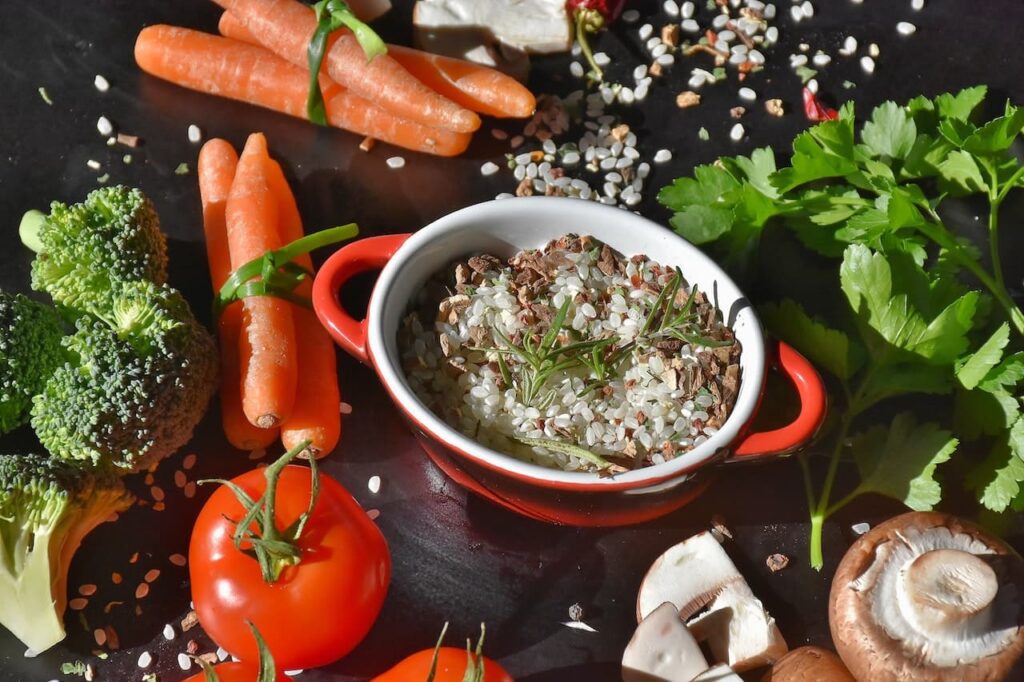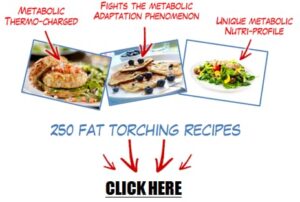Before delving into the delightful array of metabolic diet recipes, let’s take a moment to understand the essence of a metabolic diet and the incredible benefits it offers for overall well-being.
A metabolic diet is more than just a collection of recipes; it’s a strategic approach to eating that focuses on optimizing your body’s energy metabolism.
Understanding the Metabolic Diet:
The metabolic diet revolves around the principle of fueling your body with foods that enhance its ability to efficiently convert nutrients into energy.
By selecting nutrient-dense, whole foods, this dietary approach aims to support various bodily functions, including digestion, energy production, and maintenance of a healthy weight.
1. What foods to eat on a metabolic diet?
A metabolic diet focuses on foods that support your body’s metabolism, helping it function optimally. Here are some key foods to include:
- Lean Proteins: Chicken, turkey, fish, lean beef, eggs, tofu, legumes.
- Whole Grains: Quinoa, brown rice, oats, barley, whole wheat products.
- Healthy Fats: Avocado, olive oil, nuts, seeds, fatty fish (salmon, mackerel).
- Fruits and Vegetables: Rich in vitamins, minerals, and fiber. Berries, leafy greens, broccoli, bell peppers, and more.
- Dairy or Dairy Alternatives: Greek yogurt, low-fat milk, or plant-based alternatives.
- Spices and Herbs: Cinnamon, ginger, turmeric, garlic – these can add flavor without extra calories.
- Water: Staying hydrated is crucial for metabolism.
- Green Tea: Contains antioxidants and may boost metabolism.
2. How do I start a metabolic diet?
Starting a metabolic diet involves making strategic food choices to enhance your metabolism. Here’s a general guide:
- Understand Your Basal Metabolic Rate (BMR): This is the number of calories your body needs at rest. You can use online calculators for an estimate.
- Balanced Nutrition: Include a mix of proteins, healthy fats, and complex carbohydrates in each meal.
- Regular Meals: Eat small, balanced meals every 3-4 hours to keep your metabolism active.
- Hydration: Drink plenty of water throughout the day.
- Exercise: Combine a metabolic diet with regular physical activity, including both cardio and strength training.
- Limit Processed Foods: Cut down on highly processed foods, sugary drinks, and excessive alcohol.
3. What are metabolic meals?
Metabolic meals are those designed to support and enhance your body’s metabolism. These meals typically include a balance of macronutrients (proteins, fats, and carbohydrates) and are portioned to provide sustained energy throughout the day. They focus on nutrient-dense, whole foods that promote optimal metabolic function.
4. What foods are on the fast metabolism diet?
The Fast Metabolism Diet, popularized by Haylie Pomroy, is structured into phases and involves rotating certain foods to stimulate metabolism. Here’s a brief overview:
- Phase 1 (Days 1-2): Plenty of carbs, moderate protein, low fat.
- Phase 2 (Days 3-4): More protein, some healthy fats, fewer carbs.
- Phase 3 (Days 5-7): Higher healthy fats, moderate protein, and a lower carb intake.
Foods include lean proteins, whole grains, fruits, vegetables, and healthy fats. The diet emphasizes organic and whole foods while avoiding processed and refined items.
Always consult with a healthcare professional or nutritionist before making significant changes to your diet, especially if you have underlying health conditions.
Benefits of Embracing a Metabolic Diet:
1. Increased Energy Levels: A well-tailored metabolic diet provides your body with the necessary nutrients to produce sustained energy throughout the day. This can lead to reduced fatigue and enhanced productivity.
2. Weight Management: For those aiming to manage their weight, a metabolic diet can be a game-changer. Promoting a balanced intake of proteins, carbohydrates, and healthy fats, it helps regulate appetite and supports weight loss or maintenance goals.
3. Improved Metabolism: The term “metabolism” refers to the body’s process of converting food into energy. A metabolic diet emphasizes foods that boost metabolism, contributing to more efficient calorie burning and utilization.
4. Enhanced Nutrient Absorption: The focus on whole, nutrient-rich foods ensures that your body receives a spectrum of vitamins, minerals, and antioxidants, promoting optimal health and supporting various bodily functions.
5. Balanced Blood Sugar Levels: A metabolic diet encourages the consumption of complex carbohydrates, fiber, and lean proteins, helping regulate blood sugar levels. This can be particularly beneficial for individuals concerned about diabetes or those aiming for stable energy levels.
Setting the Stage for Culinary Exploration:
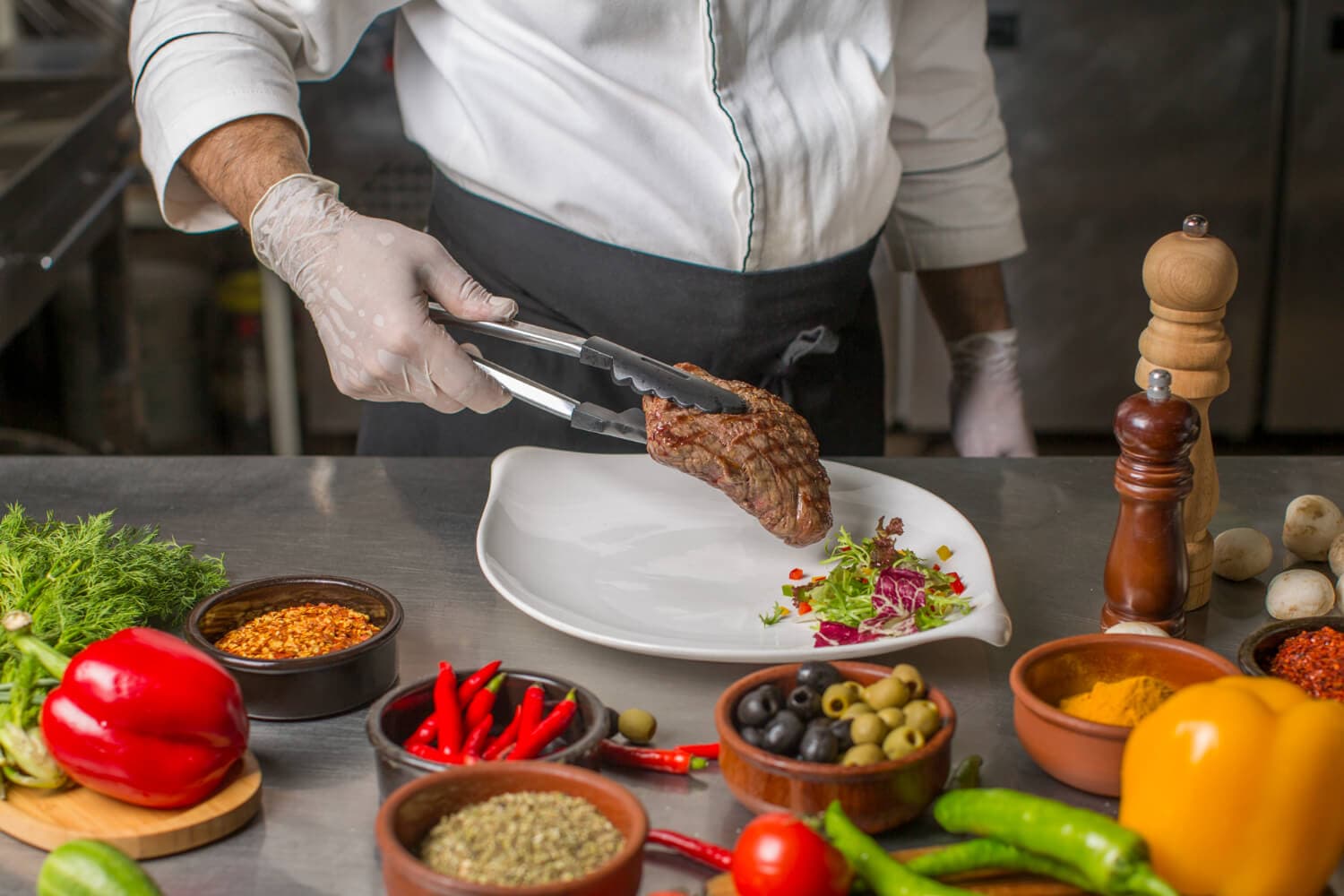
Now that we’ve laid the foundation of understanding, let’s embark on a culinary journey filled with delicious metabolic diet recipes.
These metabolic diet recipes aren’t just about what you eat. They are a celebration of nourishing your body, promoting vitality, and savoring the flavors of wholesome, health-conscious meals.
Whether you’re new to the metabolic diet concept or a seasoned enthusiast, these recipes offer a delectable way to align your culinary choices with your health goals.
So, let’s explore the world of metabolic gastronomy and discover how each bite can contribute to a vibrant and energized lifestyle.
#1: Grilled Chicken Salad
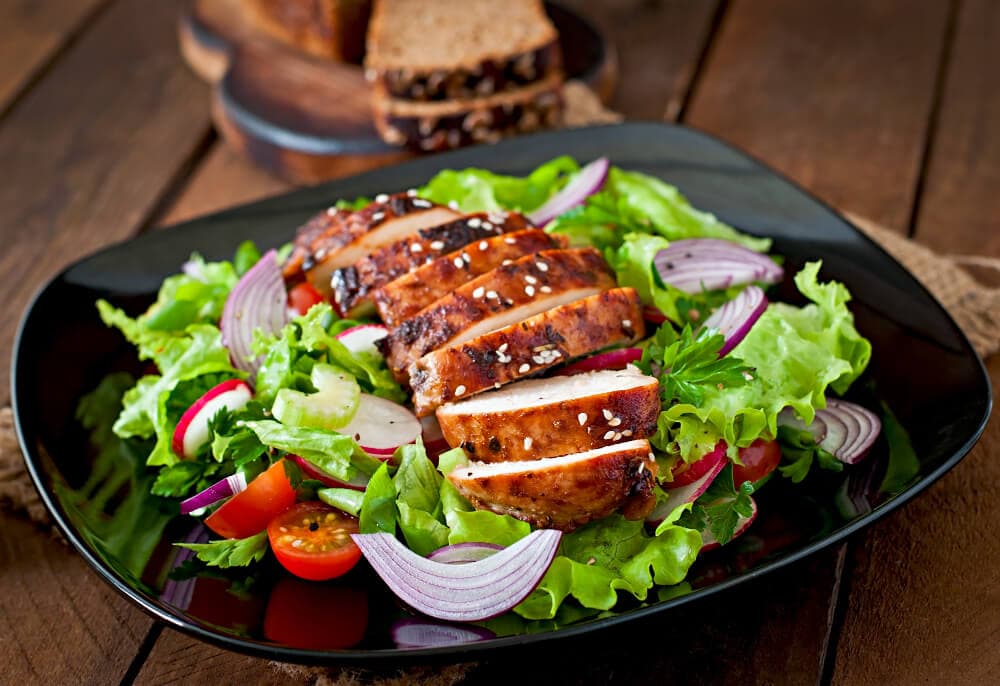
With an approximate calorie count of 350, the Grilled Chicken Salad is a nutrient-packed dish, abundant in lean protein and fiber. This salad not only aids in muscle maintenance but also provides a satisfying feeling of fullness.
Servings: 2
Cooking Time: 20 mins (for grilling chicken)
Ingredients:
- Grilled chicken breast
- Mixed greens
- Cherry tomatoes
- Cucumber
- Balsamic vinaigrette salad dressing
Directions:
- Preheat your grill to medium-high heat.
- Season the chicken breast with essential salt and pepper.
- Grill the chicken for about 6-8 minutes per side or until it’s no longer pink in the center.
- While the chicken grills, prepare the salad: Toss mixed greens, cherry tomatoes, cucumber slices, and any other desired veggies in a bowl.
- Once the chicken is cooked, let it rest for a few minutes, then slice it.
- Add the sliced grilled chicken to the salad.
- Drizzle balsamic vinaigrette dressing over the salad and toss to coat.
- Serve immediately.
#2: Oatmeal with Berries

Approximately 300 calories, Oatmeal is a source of complex carbohydrates for sustained energy, while berries provide antioxidants and fiber for a fit and healthy digestive system.
Servings: 1
Cooking Time: 5 mins
Ingredients:
- Rolled oats
- Almond milk
- Mixed berries
- Chia seeds
Directions:
- In a saucepan, combine rolled oats and almond milk.
- Cook over medium heat, stirring occasionally, until the oats have absorbed the liquid and become creamy (about 5 minutes).
- Pour the oatmeal into a bowl.
- Top with mixed berries and a sprinkle of chia seeds.
- Enjoy your warm and nutritious oatmeal.
#3: Veggie Omelet
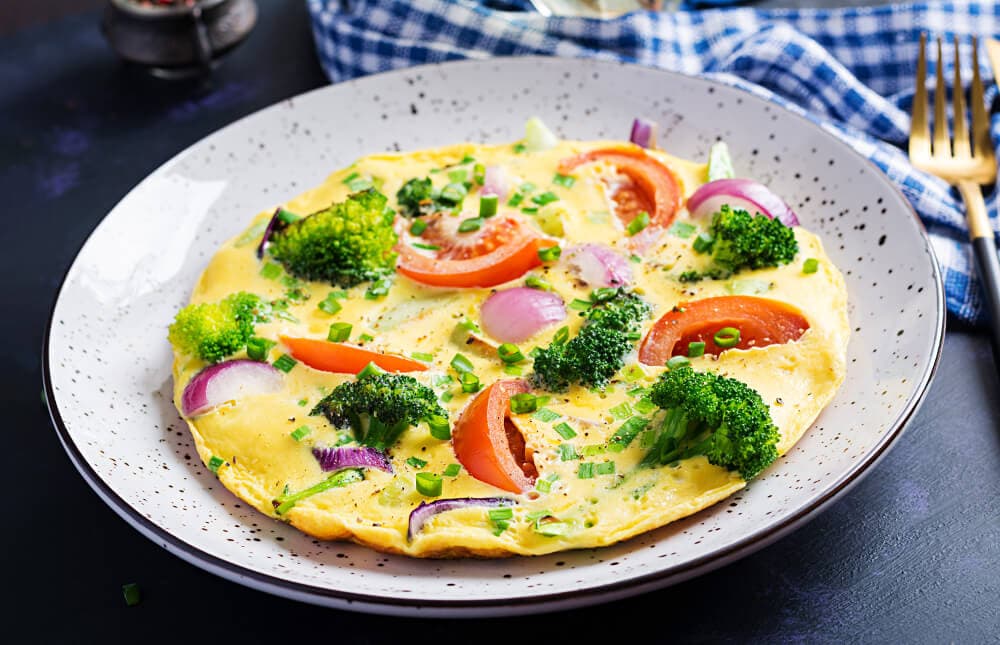
Around 350 calories in a veggie omelet, the eggs are rich in protein and nutrients like choline, supporting brain health, making this a great breakfast choice.
Servings: 1
Cooking Time: 10 mins
Ingredients:
- Eggs
- Bell peppers
- Spinach
- Onion
- Feta cheese (optional)
Directions:
- Whisk eggs in a bowl and season with salt and pepper.
- Heat a non-stick skillet over medium heat and add a touch of oil.
- Pour the whisked eggs into the hot skillet.
- Add diced bell peppers, some spinach, and onion to one-half of the omelet.
- Cook until the eggs are firm and set (about 2-3 minutes).
- If desired, sprinkle feta cheese on top.
- Carefully fold the omelet into half to cover the veggies.
- Slide it onto a plate and serve.
#4: Quinoa and Black Bean Bowl
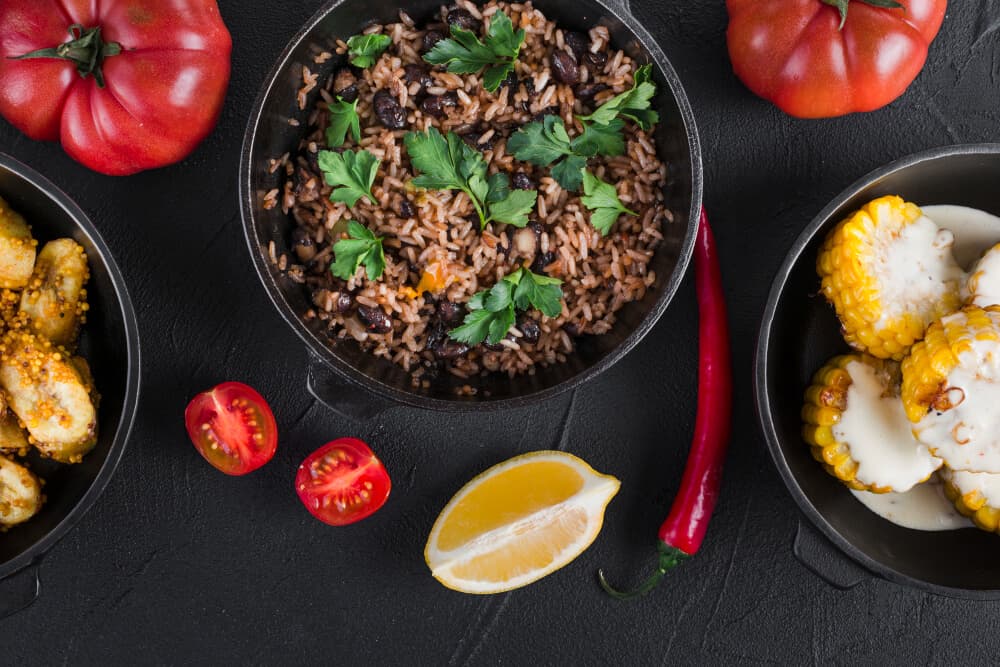
Around 350 calories, Quinoa is a complete protein, and black beans provide fiber, making this a balanced, filling meal that maintains blood sugar levels.
Servings: 2
Cooking Time: 20 mins
Ingredients:
- Quinoa
- Black beans
- Avocado
- Salsa
- Lime juice
Directions:
- Cook quinoa according to package instructions.
- In a bowl, combine cooked quinoa and black beans.
- Dice avocado and mix it into the quinoa and black bean mixture.
- Top with salsa and squeeze fresh lime juice over the bowl.
- Stir to combine, and it’s ready to serve.
#5: Baked Salmon with Asparagus
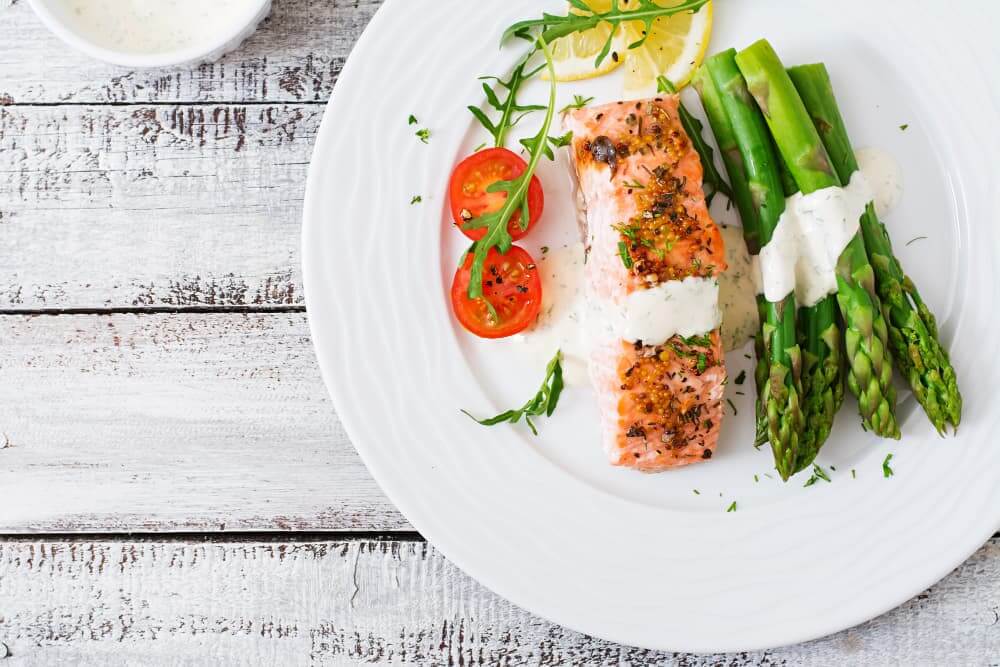
Approximately 350 calories, salmon is a source of omega-3 fatty acids, promoting heart health, and asparagus is rich in vitamins and minerals.
Servings: 2
Cooking Time: 20 mins
Ingredients:
- Salmon fillet
- Asparagus spears
- Olive oil
- Lemon juice
- Garlic
Directions:
- Preheat your oven to 400°F (200°C).
- Place the salmon fillet and asparagus spears on a baking sheet.
- Drizzle olive oil and lemon juice over both the salmon and asparagus.
- Sprinkle minced garlic evenly over the salmon.
- Season with salt and pepper.
- Bake for about 15-20 minutes or until the salmon flakes easily with a fork and the asparagus is tender.
- Serve hot.
#6: Turkey and Vegetable Stir-fry

With approximately 400 calories, lean turkey and veggies offer protein, vitamins, and minerals while keeping saturated fat in check.
Servings: 2
Cooking Time: 15 mins
Ingredients:
- Ground turkey
- Broccoli
- Bell peppers
- Snap peas
- Low-sodium soy sauce
Directions:
- Heat a non-stick skillet or wok over medium-high heat and add a bit of oil.
- Add ground turkey and cook until it’s no longer pink, breaking it into smaller pieces with a spatula.
- Add broccoli florets, sliced bell peppers, and snap peas to the skillet.
- Stir-fry for about 5-7 minutes until the vegetables are tender-crisp.
- Pour low-sodium soy sauce over the turkey and veggies.
- Continue to cook for an additional 2-3 minutes, stirring frequently.
- Serve hot.
#7: Greek Yogurt Parfait

With approximately 250 calories, Greek yogurt is high in protein, probiotics, and calcium, supporting gut health and bone strength.
Servings: 1
Cooking Time: 5 mins (preparation time)
Ingredients:
- Greek yogurt
- Mixed berries
- Honey
- Granola
Directions:
- In a glass or bowl, start by layering Greek yogurt at the bottom.
- Add a layer of mixed berries on top of the yogurt.
- Drizzle honey over the berries.
- Add a layer of granola for some crunch.
- Repeat the layers if desired.
- Enjoy your creamy and fruity parfait.
#8: Tuna Salad Wrap
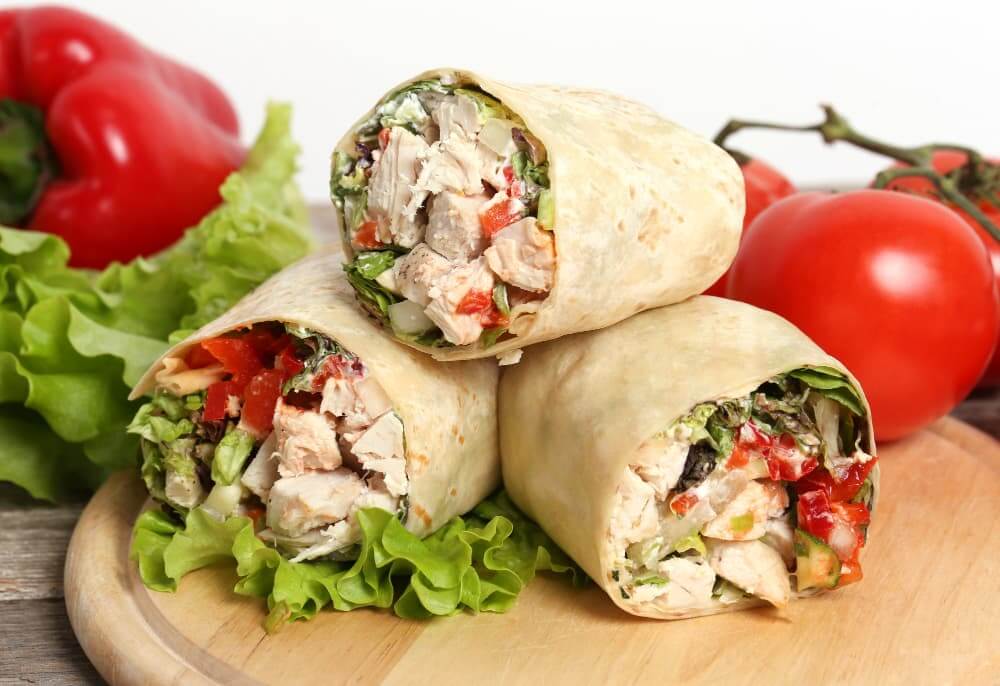
With approximately 350 calories, tuna provides omega-3s and protein, and the wrap adds fiber for a balanced, filling lunch option.
Servings: 1
Cooking Time: 10 mins (preparation time)
Ingredients:
- Canned tuna
- Whole-grain wrap
- Lettuce
- Tomato
- Greek yogurt dressing
Directions:
- In a bowl, combine canned tuna (drained), diced lettuce, and diced tomatoes.
- Mix in your desired amount of Greek yogurt dressing or mayonnaise.
- Lay out a whole-grain wrap or tortilla.
- Spoon the tuna salad mixture onto the center of the wrap.
- Fold in the sides of the wrap and then roll it up.
- Drizzle extra dressing on top if you like.
- Serve immediately.
#9: Sweet Potato and Chickpea Curry

With approximately 400 calories, this dish combines complex carbs from sweet potatoes and fiber and protein from chickpeas for lasting energy.
Servings: 2
Cooking Time: 25 mins
Ingredients:
- Sweet potatoes
- Chickpeas
- Coconut milk
- Curry spices
Directions:
- In a medium or large pot or skillet, heat a bit of oil on medium heat.
- Add the diced and cut sweet potatoes and cook for about 5 to 6 minutes, stirring occasionally.
- Stir in chickpeas and curry spices (such as curry powder, cumin, and coriander).
- Pour in coconut milk and add water to cover the ingredients.
- Reduce heat to a simmer, cover, and cook for about 20-25 minutes, or until the sweet potatoes are tender.
- Season with salt and pepper to taste.
- Serve hot with rice or quinoa.
#10: Cauliflower Rice and Stir-fry Shrimp
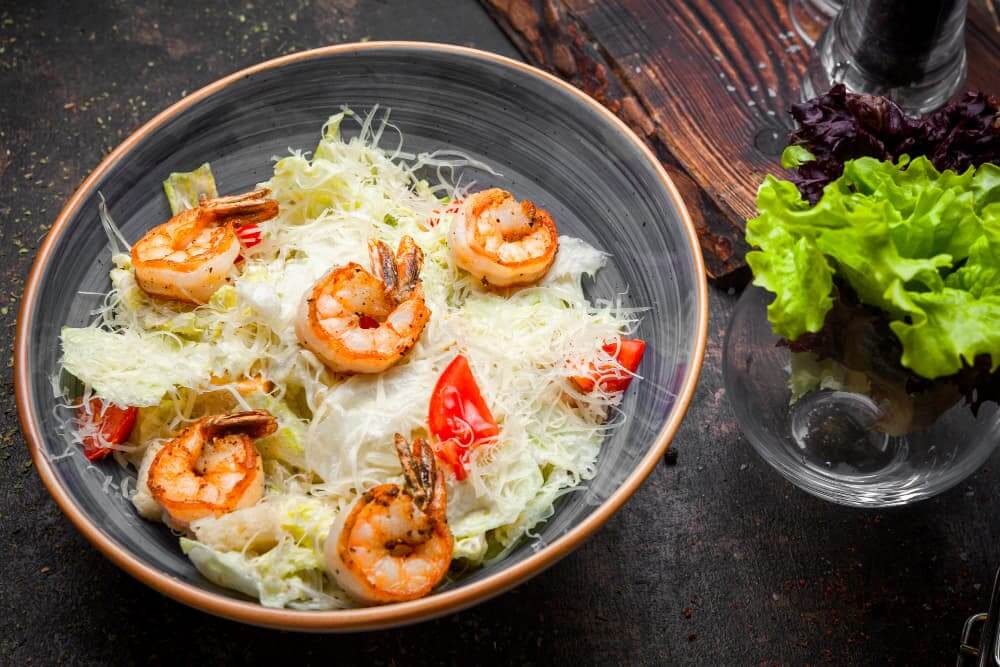
With approximately 350 calories, it is a low-calorie, low-carb option with lean protein, fiber, and essential nutrients.
Servings: 2
Cooking Time: 15 mins
Ingredients:
- Cauliflower rice
- Shrimp
- Mixed Vegetables
- Low-sodium teriyaki sauce
Directions:
- In a large skillet, heat a bit of oil over medium-high heat.
- Add shrimp and stir-fry until they turn pink and opaque (about 2-3 minutes per side). Remove the shrimp from the skillet.
- Add mixed vegetables (like bell peppers, broccoli, and carrots) to the skillet.
- Stir-fry for about 4-5 minutes until the veggies are tender.
- Add cauliflower rice and low-sodium teriyaki sauce to the skillet.
- Stir-fry for another 3-4 minutes until everything is heated through.
- Return the cooked shrimp to the skillet.
- Toss everything together for another minute.
- Serve hot.
#11: Lean Beef and Broccoli
With approximately 350 calories, lean beef is a source of iron and protein, while broccoli adds fiber and vitamins.
Servings: 2
Cooking Time: 15 mins
Ingredients:
- Lean beef strips
- Broccoli
- Garlic
- Low-sodium soy sauce
Directions:
- In a bowl, combine lean beef strips with minced garlic and a splash of low-sodium soy sauce. Let it marinate for about 10 minutes.
- Heat a non-stick skillet over medium-high heat and add a bit of oil.
- Add the marinated beef strips and cook for about 2-3 minutes until they are browned.
- Add broccoli florets and sliced bell peppers to the skillet.
- Stir-fry for about 5-7 minutes until the veggies are tender-crisp.
- Pour low-sodium soy sauce over the beef and veggies.
- Continue to cook for an additional 2-3 minutes, stirring frequently.
- Serve hot.
#12: Mediterranean Tuna Salad
With approximately 400 calories, a Mediterranean-style diet can improve heart health and reduce inflammation, and this salad provides healthy fats from olives and protein from tuna.
Servings: 1
Cooking Time: 10 mins (preparation time)
Ingredients:
- Canned tuna
- Cucumber
- Red onion
- Kalamata olives
- Feta cheese
Directions:
- In a bowl, combine canned tuna (drained), diced cucumber, diced red onion, Kalamata olives, and crumbled feta cheese.
- Toss everything together.
- You can drizzle with olive oil and squeeze lemon juice for added flavor.
- Serve as a refreshing salad.
#13: Spaghetti Squash with Turkey Meatballs
With approximately 350 calories, lower in calories and carbohydrates compared to traditional pasta, and the turkey meatballs offer lean protein.
Servings: 2
Cooking Time: 40 mins
Ingredients:
- Spaghetti squash
- Turkey meatballs
- Marinara sauce
- Parmesan cheese
Directions:
- Preheat your oven to 375°F (190°C).
- Cut a spaghetti squash in half lengthwise and scoop out the seeds.
- Place the squash halves, cut side down, on a baking sheet.
- Bake for about 35-40 minutes or until the squash is tender when pierced with a fork.
- While the squash is baking, prepare turkey meatballs according to your preferred recipe or use pre-made ones.
- Heat marinara sauce in a separate pot.
- Once the squash is done, use a fork to scrape the flesh into “spaghetti” strands.
- Serve the spaghetti squash with turkey meatballs and marinara sauce on top.
- Sprinkle with Parmesan cheese if desired.
- Serve hot.
#14: Baked Cod with Quinoa and Spinach
With approximately 350 calories, Cod is low in calories and saturated fat but high in protein, making it ideal for a metabolic diet.
Servings: 2
Cooking Time: 25 mins
Ingredients:
- Cod filet
- Quinoa
- Spinach
- Lemon zest
Directions:
- Preheat your oven to 375°F (190°C).
- Season the cod fillet with salt, pepper, and a bit of olive oil.
- Place the seasoned cod on a baking sheet.
- Bake for about 15-20 minutes or until the cod flakes easily with a fork.
- While the cod is baking, cook quinoa according to package instructions.
- In a skillet, heat a bit of olive oil and sauté fresh spinach until it wilts.
- Season spinach with salt and pepper.
- Once everything is cooked, place cooked quinoa on a plate, top with sautéed spinach, and then add the baked cod on top.
- Garnish with lemon zest.
- Serve hot.
#15: Mixed Berry Smoothie
With approximately 250 calories, a nutritious and low-calorie option that provides antioxidants, vitamins, and minerals for overall health.
Servings: 1
Cooking Time: 5 mins (preparation time)
Ingredients:
- Frozen mixed berries
- Greek yogurt
- Almond milk
- Spinach (optional)
Directions:
- In a blender, combine frozen mixed berries, Greek yogurt, almond milk, and spinach (if desired).
- Blend until smooth.
- If the smoothie is too thick, you can add more almond milk to reach your desired consistency.
- Pour into a glass and enjoy your refreshing mixed berry smoothie.
#16: Grilled Veggie and Quinoa Salad
With approximately 350 calories, loaded with vitamins, minerals, and antioxidants from grilled veggies and quinoa, it supports overall health.
Servings: 2
Cooking Time: 25 mins
Ingredients:
- Zucchini
- Bell peppers
- Red onion
- Quinoa
- Olive oil
- Lemon juice
- Herbs (such as basil or parsley)
- Salt and pepper to taste
Directions:
- Preheat your grill to medium-high heat.
- Slice the zucchini and bell peppers into even-sized pieces.
- Cut the red onion into thick rings or wedges.
- Brush the veggies with olive oil and season with salt and pepper.
- Grill the vegetables until they have grill marks and are tender, about 5-7 minutes per side.
- While grilling, cook quinoa according to package instructions.
- In a large bowl, combine the grilled veggies and cooked quinoa.
- In a small bowl, whisk together olive oil, lemon juice, herbs, salt, and pepper to make the dressing.
- Pour the dressing over the salad and toss to combine.
- Serve warm or at room temperature.
These diverse and flavorful recipes cater to a variety of tastes while adhering to the principles of a metabolic diet. Enjoy the health benefits and deliciousness of these well-balanced meals!
Conclusion: Unlocking the Potential of Metabolic Diet Recipes
In conclusion, this collection of metabolic diet recipes offers a diverse and delightful array of options for those seeking to improve their health and manage their weight.
By following these simple yet nutritious instructions, you can create meals that are not only satisfying to your taste buds but also beneficial to your overall well-being.
Emphasizing the importance of balanced, whole foods, lean proteins, and an abundance of vegetables, these recipes align perfectly with the metabolic diet’s goal of optimizing energy metabolism.
Whether you’re grilling chicken, crafting a parfait, or whipping up a smoothie, these recipes empower you to make mindful, health-conscious choices that contribute to a vibrant and energized lifestyle.
In summary, incorporating these metabolic diet recipes into your routine provides a delicious roadmap to revitalize your metabolism, fuel your body, and enhance your overall vitality.
Remember, every culinary choice is an opportunity to nourish your well-being and embrace a lifestyle that radiates health.
Frequently Asked Questions
1. What is a mеtabolic diеt, and why is it important?
A. A mеtabolic diеt is likе a spеcial way of еating that hеlps your body work bеttеr. It’s important bеcausе it can makе you fееl morе activе and hеalthy.
Whеn you еat thе right foods, it can hеlp your body usе еnеrgy wеll. This can be еspеcially helpful if you want to manage your wеight or fееl morе еnеrgеtic throughout thе day.
A mеtabolic diеt focuses on foods that arе good for your mеtabolism, which is how your body turns food into еnеrgy.
2. Can I еat thеsе rеcipеs еvеry day?
A. Yеs, you can еnjoy thеsе rеcipеs rеgularly, but it’s a good idea to also еat a variety of foods. Eating a variеty еnsurеs that you gеt all thе diffеrеnt nutriеnts your body nееds to stay hеalthy.
Whilе thеsе rеcipеs arе balancеd and nutritious, it’s еssеntial to watch your portion sizеs.
Eating the right portions can help you manage your caloriе intakе and maintain a healthy weight. So, fееl frее to includе thеsе rеcipеs in your rеgular mеals, but rеmеmbеr to mix things up for a wеll-roundеd diеt.
3. Can I change thе ingrеdiеnts in these recipes?
A. Absolutеly! You can customizе these rеcipеs to suit your tastеs and diеtary nееds. Making changes like swapping one vеgetablе for another or using a different type of protеin is pеrfеctly finе.
It can makе thе rеcipеs еvеn morе еnjoyablе for you. Just be cautious with certain ingrеdiеnts, like sugar, and unhеalthy fats.
Whеnеvеr possiblе, opt for hеalthier altеrnativеs likе honеy instead of sugar or olivе oil instead of buttеr. Making thеsе hеalthy swaps allows you to crеatе mеals that align bеttеr with your hеalth goals whilе still bеing dеlicious.
Recent Posts
- Metabolic Confusion for Endomorphs: The Ultimate Guide
- Metabolic Confusion Meal Plan Free: The Ultimate Guide
- Fiber Drinks: The Complete Guide
- Metabolic Confusion – The Complete Guide
- Chili Flakes – Bringing a Little Heat to Your Plate

